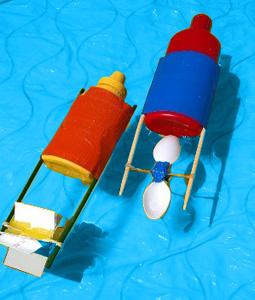Supplies:
- One plastic bottle along with its lid, about the size of a disposable water bottle (it can be a drink bottle, shampoo bottle, catsup bottle, mustard bottle, or any other clean, plastic bottle.) You can experiment with bottles of different shapes and sizes!
- Two chopsticks, new pencils, sturdy skewers, or any other straight sticks of equal size; they must be long enough to fit at least halfway along the edge of your bottle and then hang off the end by 4 to 5 inches.
- Thick foam board OR plastic carton(like a whipped cream tub or kitchen wipes container) OR two disposable plastic spoons
- Rubber bands of different sizes
- Duct tape or packing tape
- Scissors
- Paper
- Ruler
- Permanent marker
Directions:
- Line up your two sticks on opposite sides and along the length of your clean bottle; tape into place using the duct tape or packing tape (or use rubber bands if you have no tape.)
- Slide a rubber band over the ends of the sticks. Your rubber band should be taut without falling off but not so tight that it bends your sticks inward. If your rubber band is too big, try doubling it. It helps to loop the rubber band around each stick so it doesn’t fall off.
- Trace and cut a 2 inch X 3 inch template from the paper. Then use the paper template to trace 4 rectangles on the sides, bottom, or lid of a plastic container and cut them out.* The plastic should be soft enough to bend. Bend each piece in half; then use narrow pieces of duct tape to hold the pieces together with the curves flaring in opposite directions and all the bends in the middle.
- Slide your curved, taped plastic carton pieces or your taped spoons or your joined foam pieces between the sides of the rubber band. This is your paddle! At this point, you can tape the paddle to the rubber band.
- Try it out! You can sail your paddle boat in the bathtub, in a pond or quiet stream, or in a swimming or kiddie pool. Wind the paddle within the rubber band. Do it several times, but don’t wind it so much that it snaps. With the paddle still wound, set your boat gently in the water and let it go!
(Watch this project at: https://youtu.be/aFYJ9Aga7VY?list=PLxg4vmuqrAte4QgWzVQ7oInsSnnMkwcil)
* Caution: Some plastics become sharp when cut. Get an adult’s help if you need it!
Alternate method: Using a wire cutter or strong scissors, trim the handles of two plastic spoons so that they are 2 ½ inches long; use a narrow piece of duct tape to hold the spoons together along the short handle with one spoon facing up and one spoon facing down.
Second alternate method: Cut two 3 inch squares out of thick foam board and cut a slit just to the middle of each so that they can slide together.
The Science behind this Project:
The wound rubber band stores energy. The more you wind it the more energy is stored. The term for stored energy is “potential energy.” When you release the rubber band, the “potential energy” is converted into “kinetic energy,” or the energy of motion.
More experimentation:
Does the boat go faster or slower if the paddle is moved closer to the boat?
Does the boat go backwards if the paddle is wound in the other direction?
Does a big boat go faster or slower than a small boat?
When your boat is in the water, can you spot other forms of kinetic energy caused by the boat’s motion?
Can you think of other examples of potential and kinetic energy?
More ideas:
Make a balloon powered car
Make a rubber band helicopter



 We are experiencing recent outages to the online catalog, PPLD mobile app, and Libby/OverDrive. Click here to learn more.
We are experiencing recent outages to the online catalog, PPLD mobile app, and Libby/OverDrive. Click here to learn more.